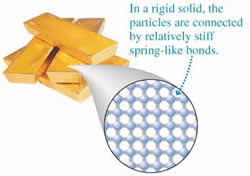Difference between Solid and Liquid
Key difference: Solid, liquid, gas and plasma are the four primary states of matter in which objects can be found on Earth. Solid is a state of matter that has a fixed shape and fixed volume. Liquid is a state of matter that has no fixed shape but has a definite volume.
 Solid, liquid, gas and plasma are the four primary states of matter in which objects can be found on Earth. Almost all substances can be found in either one of these four states. Water is the best example that can be used to describe states of matter as it can be found abundantly in three of the four states, ice (solid), water (liquid) and vapor (gas). While lighting or neon gases constitute as plasma.
Solid, liquid, gas and plasma are the four primary states of matter in which objects can be found on Earth. Almost all substances can be found in either one of these four states. Water is the best example that can be used to describe states of matter as it can be found abundantly in three of the four states, ice (solid), water (liquid) and vapor (gas). While lighting or neon gases constitute as plasma.
Solid is a state of matter that has a fixed shape and fixed volume. A solid is made up of tiny particles of matter such as atoms and molecules that are held together by chemical bonds. The atoms and molecules are held rigidly in place that does not allow the solid to change shape or volume. Hence, a solid cannot fill out the shape of a container like a liquid or fill the every space of a container like a gas.
The atoms and molecules in a solid are tightly bound to each other in either a regular geometric lattice or irregularly. The regular geometric lattice is most common and can be found in most solids, including ice. Solids with irregularly bound atoms are known as amorphous solids. This includes glass and polystyrene.
When some solids are heated, the energy from the heat is absorbed by the atoms. The atoms then get exited and start to move around. The bonds that held the atom in place tend to loosen, allowing the atoms to move further away from each other. Essentially, this is the process of melting. When the solid has melted thoroughly, it is then deemed to be a liquid.

Liquid is a state of matter that has no fixed shape but has a definite volume. Liquid is made up of tiny particles of matter such as atoms and molecules that are held together by chemical bonds. Liquid shares many of its characteristics with the solid and gaseous states. Such as similar to a gas it is free-flowing and can take the shape of the container it is placed in, however unlike a gas it cannot fill every space of the container. The density of liquid is closer to solid than gas and both are termed as condensed matter. A distinctive property of the liquid state is the surface tension that results in wetting objects when dipped into it.
Liquid particles are bounded firmly but not rigidly, which gives it the ability to flow. They are also able to move around one another freely, with limited particle mobility. The transformation of liquid to other states has to do with its molecules; as liquid is heated the molecules increase in vibrations and movement causing them to create greater distances between them. As the distance increases, after a while the liquid turns into a gas. During solidification, as the liquid is cooled, the molecules come together and form a specific order, known as crystallizing. The bonds between them become more rigid and stronger, and eventually come together to become a solid. Water is the most abundant liquid on the Earth and is considered a necessity for sustenance of life.
Image Courtesy: cmapspublic.ihmc.us, whs.wsd.wednet.edu









Comments
Sahil Debnath
Mon, 01/15/2018 - 18:00
Add new comment